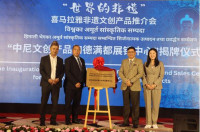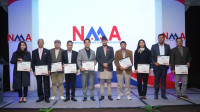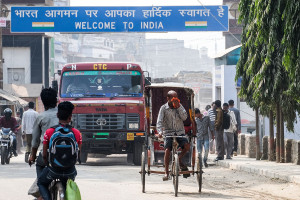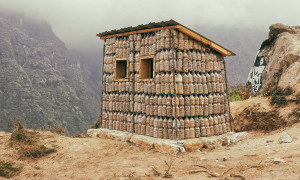Money
Nepal shifts gears as EVs hit 73 percent of 4-wheeler imports
China dominates Nepali EV market as the hydropower-rich country struggles to align energy policies.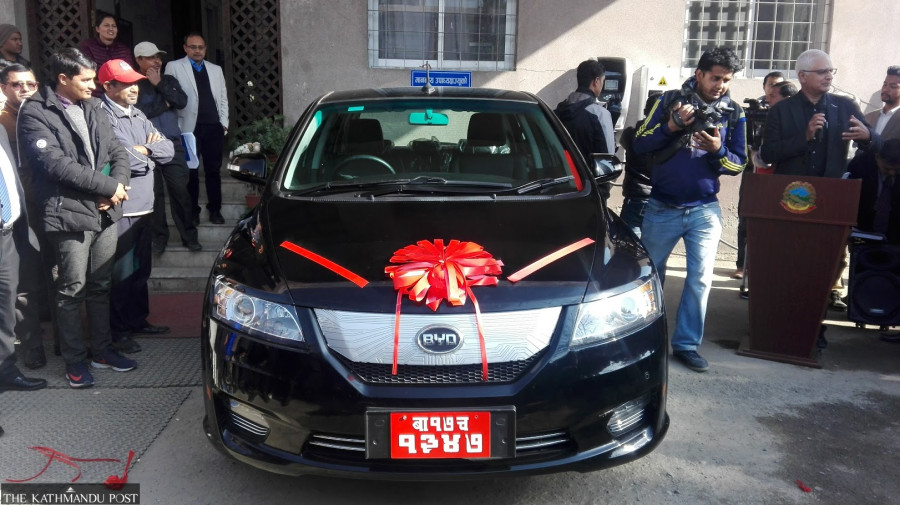
Krishana Prasain
In December 2017, Nepal’s National Planning Commission—tasked with framing the country’s policies and programmes—became the first government agency to buy an electric vehicle (EV). There was a celebratory event on its premises when the commission acquired a long-range BYD e6, manufactured by China’s leading EV company, Build Your Dreams (BYD), for Rs6 million.
At the event, Swarnim Wagle, then vice chair of the commission, remarked that purchasing one car was part of a broader push to replace the petrol and diesel vehicles used by government agencies with electric alternatives.
The audience responded with laughter.
Today, though the extent of EV adoption within government agencies remains unclear, EV imports have surged nationwide. In the fiscal year that ended on July 16, EVs accounted for a staggering 73 percent of all four-wheeled passenger vehicle imports—among the highest rates globally.
Imports of four-wheelers, including passenger buses, microbuses, and private vehicles, rose by 27.04 percent year-on-year, with EV imports climbing 23.33 percent. Nepal imported 22,907 four-wheelers worth Rs50.88 billion, of which 16,701 units were EVs valued at Rs41.23 billion.
By contrast, just five years earlier in fiscal 2019-20, Nepal imported only 236 EV units—primarily from China—worth Rs674 million. That same year, imports of petrol and diesel-powered vehicles totalled 10,310 units worth Rs9.24 billion.
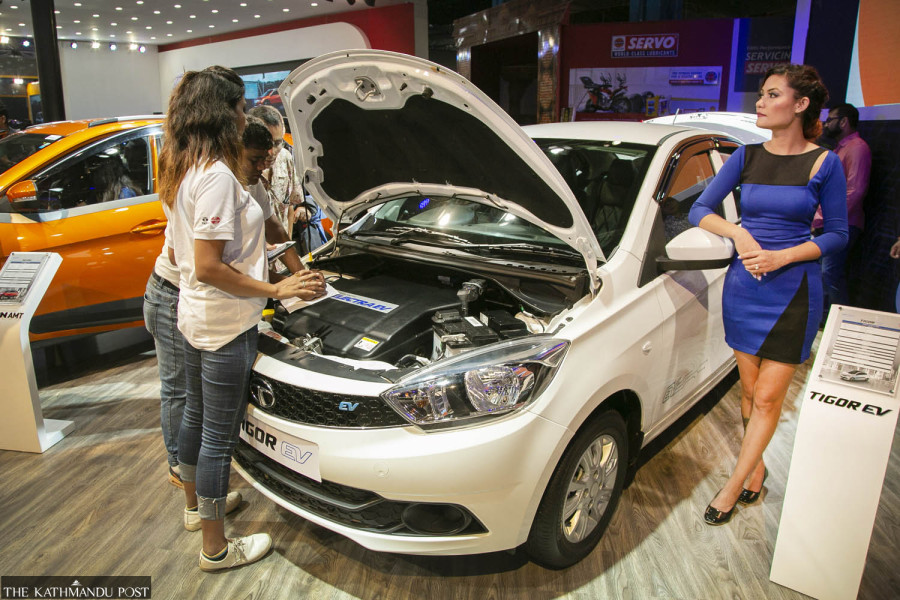
Nepal’s EV journey began as early as 1975 with the introduction of Chinese-donated trolley buses in Kathmandu. However, due to poor maintenance and financial constraints, the system shut down in 2009. In 1993, Kathmandu’s streets saw the emergence of battery-powered Safa Tempos (three-wheelers), which replaced the diesel-operated Vikram Tempos. However, privately owned EVs only began to gain momentum in the late 2000s when the Indian automaker Mahindra introduced the Reva model.
Now, Nepal has entered the era of modern EVs.
Sales are booming.
“We sold nearly 3,600 BYD units last fiscal year and expect higher numbers this year, given the growing demand and interest in EVs,” said Yamuna Shrestha, managing director of Cimex Inc., the authorised BYD distributor in Nepal. “The country made significant progress in EV adoption last fiscal year, with EVs comprising around 75 percent of automobile imports.”
Shrestha believes long-term policy stability is crucial if the government aims to achieve net-zero greenhouse gas emissions by 2045. “The government says it wants 30 percent of heavy passenger vehicles to be electric, but we’re currently only at about 7 percent,” she noted.
Last fiscal year, the loan financing cap for EVs was reduced from 90 percent to 60 percent. “We reviewed the banks’ hire-purchase loan data and found no defaults. These abrupt policy changes are counterproductive if the goal is to increase electricity consumption, reduce fossil fuel imports, and reach net-zero.”
Electric minibuses have also gained traction, particularly on winding hill roads leading to the southern plains and in schools and colleges, where the operating and transport costs of traditional large buses are high.
Electric vehicles have overtaken fossil-fuel vehicles in import volume, marking a milestone in the country’s shift to cleaner transport.
According to the government’s Long-Term Strategy for Net-Zero Emissions report published in 2021, Nepal’s carbon dioxide (CO2) emissions stood at 23 million metric tonnes (mMtCO2) in 2019 under the reference scenario. This is projected to rise to 34 mMtCO2 by 2030 and 79 mMtCO2 by 2050. In 2019, around 54 percent of emissions came from the energy sector and 46 percent from non-energy sectors.
The strategy envisions that by 2025, EVs will make up 25 percent of all private vehicle sales—including two-wheelers—and 20 percent of four-wheeled public passenger vehicles, excluding electric rickshaws and three-wheelers. By 2030, the targets rise to 90 percent of private passenger vehicle sales and 60 percent for public four-wheelers. The plan also includes building a 200-kilometre electric railway to bolster public and freight transport.
“All government offices have been increasingly opting for EVs in recent years, except those requiring frequent travel to remote areas with limited charging facilities,” said Maheshwar Dhakal, joint secretary and head of the Climate Change Management Division at the Ministry of Forests and Environment. “There’s little difference in cost between EVs and fossil-fuel vehicles for government use, as neither is taxed.”
.jpg)
Dhakal, however, cautioned that switching to EVs alone will not be enough. “EV adoption is just one part of achieving net-zero emissions by 2045. Much more needs to be done.”
Despite Nepal’s sluggish economy, EV sales remain resilient. However, auto dealers say most buyers depend on loans and feel the impact of reduced financing.
Last fiscal year, Nepal Rastra Bank’s mid-term monetary review lowered the maximum loan financing for EVs to 60 percent, while raising it to the same level for petrol and diesel vehicles—from 50 to 60 percent. In April, the central bank further amended its policy, reducing bank financing to 60 percent for companies offering hire-purchase loans, down from 90 percent.
Sipradi Trading, the authorised Tata Motors distributor in Nepal, echoed concerns that this change in financing has hurt lower-segment buyers, who rely most on loans.
“The reduction in financing has especially affected buyers of affordable EVs,” said Aviruchi Giri, marketing manager at Sipradi. “Without the finance cap, sales in the lower segment would likely have risen further.”
Tata’s EV sales rose 11 percent last fiscal year over the previous year. “We launched three new EV models priced up to Rs5 million, which did well in the market,” said Giri. The price of Tata EVs range from Rs2.74 million to Rs5.69 million.
BYD EVs range from Rs4.1 million to nearly Rs10 million, with top-selling models being the Dolphin (Rs4.11 million) and Atto 3 (Rs5.6 million).
Even with tightened loan policies, hire-purchase loans rose 5.5 percent to Rs6.85 billion in the first 11 months of the last fiscal year, ending in mid-June.
On policy uncertainty, Dhakal insisted Nepal’s EV policies have been stable for four to five years. “The government’s incentives have mostly helped private buyers, but public mass transport, especially on long routes, needs to switch to EVs.”
However, contradictions persist.
The government continues investing billions in petroleum and LPG infrastructure, drawing criticism from hydropower advocates who fear this could undermine Nepal’s clean energy potential. Nepal is building many oil pipelines, which experts say belies Nepal’s green energy policy.
However, the adoption of EVs and petroleum imports has been growing.
Nepal imported 746,420 kilolitres of petrol worth Rs64.12 billion in the last fiscal year—a volume increase of 8.5 percent, though the value fell by 5.84 percent.
Diesel imports stood at 1.46 million kilolitres, worth Rs128.76 billion—a 3.88 percent increase in quantity, but a 10.56 percent drop in cost.
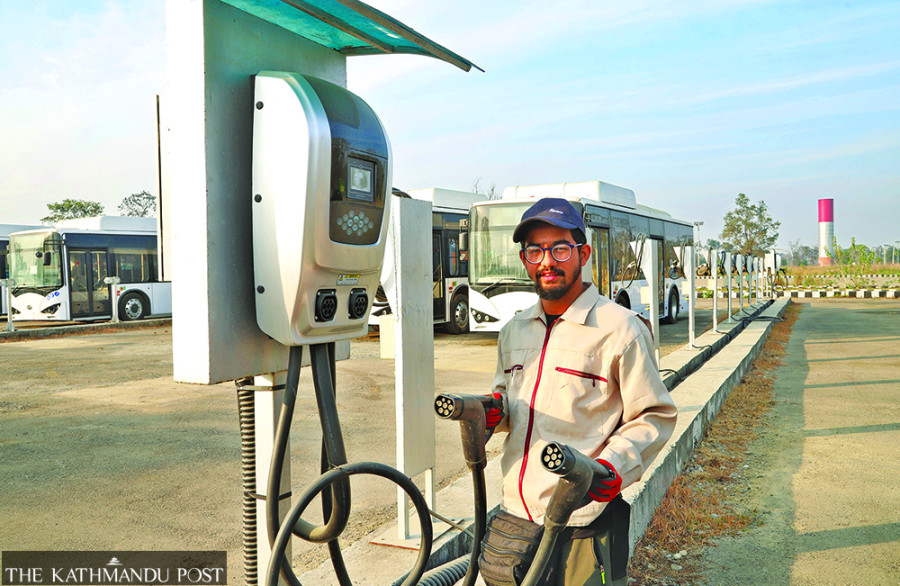
While Nepal will take time to cut fossil fuel imports, policy direction, experts argue, should support maximising domestic hydropower—from kitchens to cars.
According to automobile dealers, the number of EV importers has grown to about 50, up from just 10 a few years ago, indicating surging demand.
The benefits of EVs are manifold.
They produce zero tailpipe emissions, helping to mitigate air pollution—a significant problem in Nepal’s urban centres—and align with the country’s climate commitments. Economically, EVs reduce reliance on costly fuel imports, potentially easing the trade deficit over time.
Their lower operating and maintenance costs also offer consumers long-term savings. Moreover, the expanding EV sector opens avenues for new businesses in charging infrastructure and vehicle servicing.
Consumers increasingly prefer EVs not just for environmental reasons, but also for their quieter, smoother ride.
Chinese EVs dominate Nepal’s import market. Of the Rs41.23 billion spent on EVs last fiscal year, Rs34.20 billion went toward Chinese models. India followed with Rs6.47 billion, while imports from Indonesia, South Korea, Germany, Malaysia, and the US totalled Rs554.47 million.
Nepal imported 13,338 EVs from China, 3,247 from India, and 116 from other countries.
Motorcycles remain popular, too. Last fiscal year, Nepal imported 55,930 assembled motorcycles worth Rs6.04 billion and 146,022 unassembled motorcycles worth Rs18.45 billion. Electric two-wheelers are catching on, with 11,320 units worth Rs1.06 billion imported.
Still, dealers say fossil-fuel motorcycles dominate due to Nepali riders’ preference for heavy bikes.




 9.12°C Kathmandu
9.12°C Kathmandu
